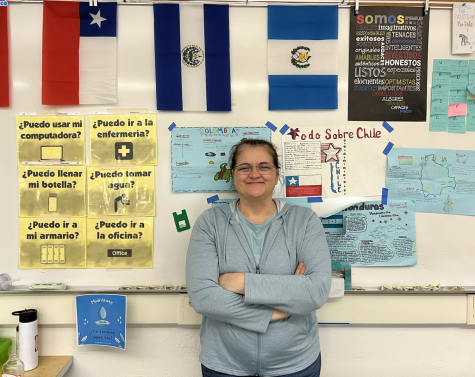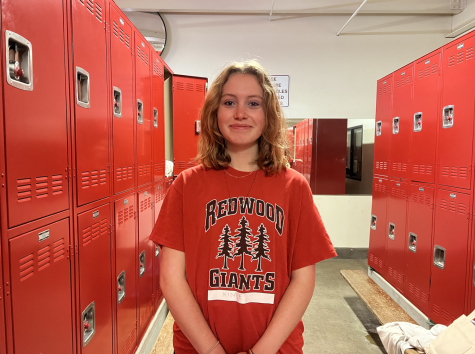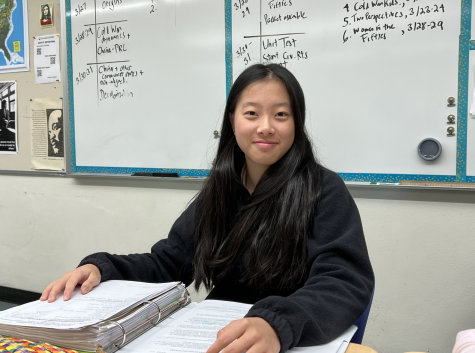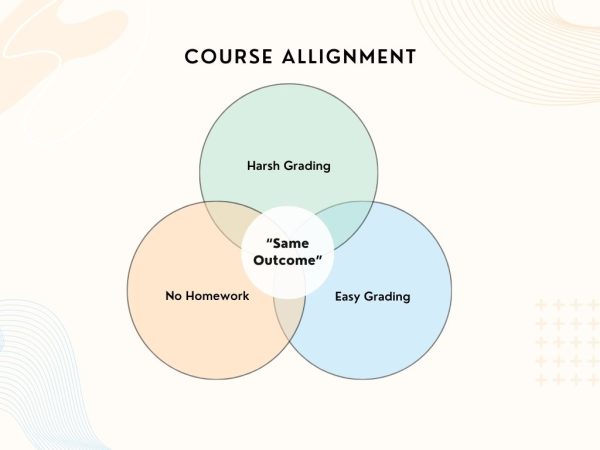Sharing stories: The lives of first-generation immigrants at Redwood
April 27, 2023
“America was built by immigrants.” This is a phrase that most have heard while living in this country. Every part of American culture, from food and sports to the arts, was introduced by immigrants. Yet, the United States is divided, still deciding where it stands concerning the acceptance of immigrants. However, through strong will and loyalty to this country, immigrants made themselves critical players in the foundation of America as it is known today — a country full of culture, free for all. Many of them, teachers and students alike, have found themselves here, at Redwood High School.
Roaming the halls of Redwood’s main building, there is one hallway that often sticks out. With its vibrant colors of red, orange and purple, and its intricate depictions of skulls, flags and welcoming phrases, the Spanish hallway catches the attention of all who walk by. Maria Civano, a teacher with a beaming smile and joyful energy, is the department’s head. Like many other teachers at Redwood, she immigrated to this country from South America.
Growing up in Uruguay, Civano described her childhood with a tone of sadness. However, Civano came when she was 24 for her husband’s job in Connecticut, not as a child, which she believes to be a privilege.

“I was almost an adult in a way. I can’t imagine my students who come when they’re 12, 13 [or] 15. They come to school and have to learn all of these subjects while also learning the language. For me, it was a matter of ‘what if I didn’t come,’ rather than, ‘I have to go,’” Civano said.
Unfortunately, her first experiences in America were far from easy. She describes her first years living in the United States as horrible, gray and depressing. With her family so far away, Civano found loneliness consuming her, preventing her from working. But Civano persevered. After learning English for three years, she was able to get the credentials she needed to immediately start teaching.
Civano’s new life in America hasn’t suppressed her love for Uruguay, which she makes sure to share with her children. Through music, food and traditions, Civano keeps her native culture alive while at the same time combining it with American customs. Nonetheless, she is often made aware of the cultural differences separating her from other Americans.
“There is a different take on friendship in this country. We are, for example, in my country, touchy-feely. We touch each other, we hug, we kiss. What I noticed is that in America some people are really friendly, but to an extent. They are friendly, but they don’t let you into their lives,” Civano said. Finding good friends was a struggle because of this cultural disconnect.
This disconnect is a commonality for other individuals as well. Sophomore Isabella O’Brien, born in La Coruña, Spain, recalls the same feeling.
“It’s hard to connect fully on all levels when someone doesn’t truly understand your experience and to fit into a place where sometimes people can be really ignorant,” O’Brien said.
Born to an Argentinian mother and a British father, O’Brien says her family had wanted to leave Spain for a while. In Spain, the private Catholic school systems that preached sexism and stripped students of creativity appealed to neither O’Brien’s parents nor herself.
Blonde-haired and light-eyed, O’Brien said she and her sister felt like outcasts in Spain.
“I was an outsider there too because my parents were from different countries. And we’d moved to Spain in the part where most of the people there had lived there for generations and generations. So we were outsiders, and we got treated differently,” O’Brien said.

As a result, her ability to speak Spanish and share her culture with others has always been questioned.
Here at Redwood, O’Brien’s experience is better. But, the environment is often not so welcoming for those coming from other countries or backgrounds.
“I avoid a lot of people because I feel like this school is filled with a lot of privileged people that are very hard to connect with on a realistic level because their view of reality is so out of touch,” O’Brien said.
In addition, the pandemic has made it hard for her to stay connected with her family in Britain. She says that she has become the only Spanish speaker in her family.
The Redwood experience O’Brien described shared similarities with the experience of sophomore Jennie Liu, who was born in Beijing, China. Liu was very optimistic about life at Redwood. She believes that Redwood is welcoming of new cultures, even though there aren’t many Chinese kids for her to connect with. For her, the hardest part of life in America was the first couple of years. Liu came to this country at age 10, and although she knew English beforehand, she still felt anxious about her new life.
Liu’s parents were a great source of comfort for her. Her father went to school at San Jose State and helped Liu adjust by sharing his experiences in America.

“We chose to come here because my dad thought the education was better here, having gone to school in the States. My parents taught me to not be scared to talk in class. Like, if you want to say something, say it even if you’re scared to,” Liu said.
Sometimes, Liu feels like an outsider when other students reminisce on their childhoods. American teens often bond over certain shows, music and movies that they all grew up on, and Liu cannot relate to that collective experience, which can feel isolating at times.
Yet, Liu is able to stay fully connected to China and her culture at home.
“I speak Chinese at home, and my mom cooks Chinese food. We also keep in touch with friends in China,” Liu said.
Differences between these stories are apparent, but the commonalities hold great importance. The feelings of isolation, the anxiousness of coming to a new country and feeling othered at times are all issues that first-generation immigrants face. Redwood understands these struggles, but there are always improvements to be made.
As a teacher, Civano openly touched upon these necessary improvements.
“Redwood has a lot to do, I think still because we are mainly a white school. And I believe there is some entitlement from students, staff, and families too. I think that some kids do not feel welcome…they can’t find an adult that can empower them…the experience for white students is different from the experiences of students of color, and there is a lot of learning that has to happen,” Civano said.
Here at Redwood, it is up to the teachers to turn classrooms into communities, and it is up to the students to look inside, recognize privileges, and reach out to others. Being empathetic and curious about the experiences of others is how America stays a nation of diversity and becomes one of inclusion. 






















